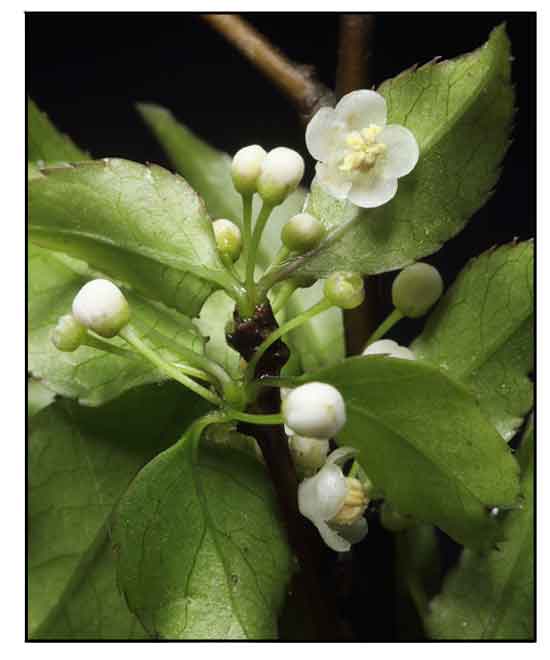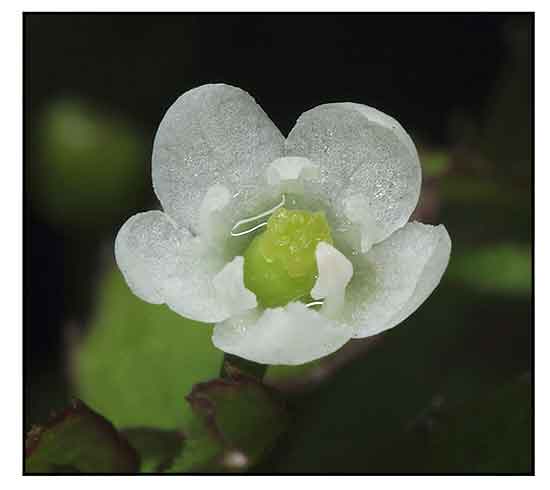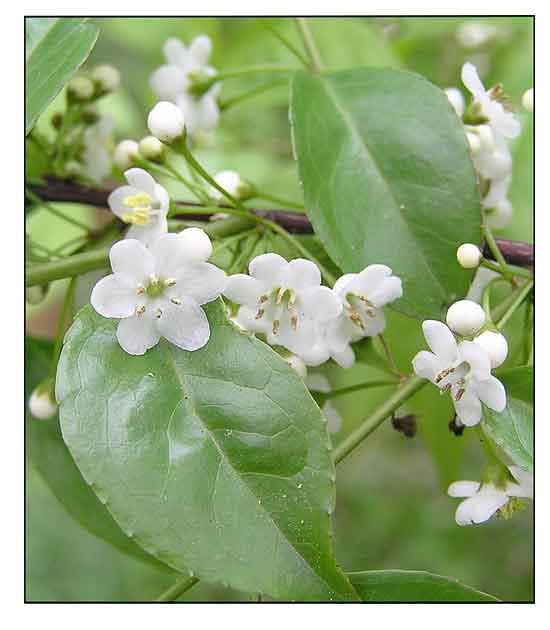 Gen info Gen info
- Ilex, or holly, is a genus of over 570 species of flowering plants in the family Aquifoliaceae, and is the only living genus in the family.
-
Ilex asprella is one of the few deciduous species in the family Aquifoliaceae.
- Etymology: The genus name Ilex derives from Latin, meaning "holm-oak or evergreen oak (Quercus ilex). (23)
- Despite the Linnaean classification of Ilex as holly, in late 19th century Britain, Ilex was being applied to oak as well as holly, possibly due to superficial similarity of the leaves. The type species Ilex aquifolium refers to the common European holly used in Christmas decorations and cards. (23)
Botany
• A densely branched deciduous shrub, growing up to 3 m tall. Shoots long, glabrous, brown, and slender, while the short shoots green with significant white lenticels. Leaves thin-chartaceous, glandular-punctate on the back, ovate, 4 to 5 cm in length, 1.5 to 2.5 cm broad. Leaf apex acuminate, leaf base cuneate, leaf margin sermlate, hirsute on adaxial nerves and nearly glabrous beneath. Petioles 3 to 8 mm long. Reticulate veins with 6 to 8 pairs of pinnate lateral veins. Flowers white, in axillary umbels with slender pedicels, dioecy. Male flower: 2 to 5 flowers each inflorescence, 2.5 to 3 mm in diameter, glabrous; 4 or 5 suborbicular petals, margin erose, corolla rotate, base slightly connate; stamens ca. 3/4 as long as petals, anthers oblong and ca. 1 mm. Female flower: 4 to 6 flowers each inflorescence, glabrous, ca. 3 mm in diameter; flowers 4-6; calyx deeply 4 to 6 lobed; corolla rotate, petals suborbicular, basal slightly connate; staminodes ca. 1 mm, sterile anthers sagittate; ovary ovoid, ca. 1.5 mm in diameter, style present, stigma thickly discoid. Drupe black and globose, endocarp stony, 5 mm long, 4 mm across, pedicel 2 to 3 cm long. (22)
Distribution
- Native to the Philippines.
- Batan, Biliran, Abra, Bataan, Benguet, Camarines Sur, Ilocos Sur, Isabela, Laguna, Mountain Province, Rizal, Zambales, Mindoro, Negros. (2)
- Also native to China Southeast, Taiwan. (1)
 Constituents Constituents
- Study of roots isolated a novel saponin containing suphonic groups, namely, asprellcoside A (1) and a known phenolic glycoside compound (2). (see study below) (3)
- Phytochemical study of leaves isolated eleven compounds: kaempferol-3-O-β-D-6″-acetylgluco-pyranoside (1), kaempferol-4′-methylether (2), quercetin (3), quercetin-3-O-glucopyranoside (4), tormentoside (5), suavissimoside R1 (6), 3β,19α-dihydroxyolean-12-ene-24,28-dioicacid-28-O-β-D-glucopyranoside (7), 3-O-β-sulfooxy-19-hydroxy-urs-12-ene-28-oic acid (8), coniferin (9), adenoside (10), 1′-O-benzyl-α-L-rhamnopyranosyl-(1″→6′)-β-D-glucopyranoside (11). (6)
- Study of roots isolated four triterpenoid glycosides and identified as
(3β)-19-hydroxy-28-oxours-12-en-3-yl β-D-glucopyranosiduronic acid n-butyl ester (1), ilexasoside A (2), monepaloside F (3), and ilexoside A (4). (8)
- Study of roots isolated six new triterpene saponins, ilexasprellanosides A–F (1–6, resp.), along with eleven known compounds were isolated from the roots of Ilex asprella. The saponins were characterized as ursa-12,18-dien-28-oic acid 3-O-β-D-xylopyranoside (1), 19α-hydroxyursolic acid 3-O-β-D-(2′-O-acetylxylopyranoside) (2), 19α-hydroxyursolic acid 3-O-β-D-glucuronopyranoside (3), 3β,19α-dihydroxyolean-12-en-23,28-dioic acid 28-O-β-D-glucopyranoside (4), 19α-hydroxyoleanolic acid 3-O-β-D-(2′-O-acetylxylopyranoside) (5), 19α-hydroxyoleanolic acid 3-O-β-D-glucuronopyranoside (6). (see study below) (9)
 - Study of roots isolated two new sulfur-containing triterpenoid saponins, asprellanosides A (1) and B (2), along with 10 known compounds (3-12). (see study below) (10) - Study of roots isolated two new sulfur-containing triterpenoid saponins, asprellanosides A (1) and B (2), along with 10 known compounds (3-12). (see study below) (10)
- Study of roots isolated five new (1-5) and 28 known triterpenoids (6-33). (see study below) (11)
- Study of roots isolated ten triterpenes and triterpenoid saponins, identified as
28-O-β-D-glucopyranosyl pomolic acid (1), ilexoside XXIX (2), ilexoside B (3), monepaloside F (4), oblonganoside B (5), 3-O-β-D-xylopyranosyl-3β-hydroxyurs-12, 18(19)-dien-28-oic acid 28-β-D-glucopyranosyl ester (6), ilexsaponin B (7), randialic acid B (8), ilexolic acid (9), and 19-dehydroursolic acid (10), respectively. (13)
- Study of roots isolated asprellosides A-K, nine new ursane-type triterpenoid glycosides (1–9), and two new oleanane-type triterpenoid glycosides (10 and 11), including six rare sulfated triterpenoid glycosides. (14)
- Study of EtOH extract of dried leaves of Ilex asprella isolated three new p-coumaroyl triterpenes, asprellic acids A,B, and C (1-3). (see study below) (15)
- Study of stems isolated eight new phenolic constituents, asprenols A-H (1-8), along with 12 known ones. (see study below) (16)
-
Study of root isolated three new sulfated triterpene glycosides, asprellanosides C–E (1–3), elucidated as 3β-[(2-O-sulfo-β-d-xylopyranosyl)oxy]urs-12,19(29)-diene-28-oic acid 28-β-d-glucopyranoside (1), 3β-[(2-O-sulfo-β-d-xylopyranosyl)oxy]urs-12,19-diene-28-oic acid 28-β-d-glucopyranoside (2), and 3β-[(2-O-sulfo-β-d-xylopyranosyl)oxy]urs-12,19-diene-28-oic acid (3). (17)Â
- Study of CHCL3-soluble fraction of 95% EtOH extract of roots isolated three new 24-nortriterpenoids, together with a known nortriterpenoid. The new compounds were elucidated as he new compounds were elucidated as 2,6β,20β-trihydroxy-3-oxo-11α,12α-epoxy-24-norursa-1,4-dien-28,13β-olide (1), 2,6β-dihydroxy-3-oxo-11α,12α-epoxy-24-norursa-1,4,20(30)-trien-28,13β-olide (2), and 2,6β-dihydroxy-3-oxo-11α,12α-epoxy-24-noroleana-1,4-dien-28,13β-olide (3). (20)
- Study of stems isolated three new
triterpenoid saponins, namely asprellinoids A–C (1–3). (21)
Properties
- Root considered antiphlogistic, depurative, febrifuge, sialogogue.
- Studies have suggested antiviral, anti-platelet aggregation, immunoregulatory, anti-inflammatory, cytotoxic, anti-tumor, anticomplement properties.
Parts used
Roots, leaves.
Uses
Edibility
- Roots used as herbal tea ingredient.
- In China, root consumed as soup ingredient.
Folkloric
- Leaves used for treatment of gonorrhea and snakebites.
- Decoction of roots used for treatment of fever, colds, laryngitis, tonsillitis.
- In China, used for treatment of influenza, pertussis, amygdalitis.
- In traditional Chinese medicine, roots used to clear 'heat', scatter stasis, detoxificate and treat anemopyretic cold, acute and chronic pharyngitis, headache, lung abscess, pertusiis, trachheitis. Root used in herbal tea to relieve summer heat and for fluid production effects. (4) Root smashed and applied on skin for itching. Roots and rhizomes used to stimulate saliva and reduce thirst.
Studies
• Antiviral / Anti-Platelet Aggregation / Roots: Study of roots isolated a novel saponin containing suphonic groups, namely, asprellcoside A (1) and a known phenolic glycoside compound (2). Both compounds strongly inhibited influenza virus strain A/Puerto Rico/8/1934(H1N1) with EC50s of 4.1 and 1.7 µM, respectively. Compound 1 significantly inhibited platelet aggregation, with suppression rate of 47 and 38% at 60 and 80 µM, respectively. Results suggest potential as valid therapeutics against influenza virus infection and asprellcoside as a novel agent for treating thrombosis. (3)
• Immunoregulatory Polysaccharides / Roots: Study of roots isolated two polysaccharides, namely IAPS-1 and IAPS-2. The polysaccharides were evaluated for immunoregulatory activity using murine macrophages. IAPS-2 polysaccharide more effectively enhanced the secretion of major inflammatory cytokines in macrophages, such as TNF-α, IL-1ß, IL-12, compared to IAPS-1. (4)
• Amelioration of Acute Viral Respiratory Distress / Roots: Study investigated the effect of Ilex asprella on acute respiratory distress syndrome (ARDS) induced by H1N1 virus in mice. Ilex asprella at 500 mg/kg effectively diminished mortality rate and ameliorated lung edema and inflammation. IA extract significantly depressed the expression of IL-6 TNF-α and MCP-1, and significantly increased expression of IL-10 and IFN-γ in serum. The extract reduced lung viral load and improved pulmonary ventilation. Results suggest potential ARDS treatment through attenuation of systemic and pulmonary inflammatory responses and inhibition of viral replication. (5)
• Anti-Inflammatory / Effect on Signaling Pathways: Study evaluated the in vivo anti-inflammatory effects of IA extracts using models of xylene-induced ear edema in mice and carrageenan-induced paw edema in rats. Intragastric administration of root extracts and stem extracts (SIA) significantly mitigated ear edema in mice and reduced paw edema in rats. Both RIA and SIA aqueous extracts exhibited anti-inflammatory effects in vivo in a dose-dependent manner. The underlying mechanisms were attributed to inhibition of pro-inflammatory cytokines TNF-α, IL-6, IL-1ß via regulation of the NF-kB JAK2/STAT3, and MAPK signaling pathways. Results support the use of IA as an anti-inflammatory herbal medicine. (7)
• Triterpene Saponins / Cytotoxicity against Human Tumor Cell Line A549 / Roots: Study of roots isolated six new triterpene saponins, ilexasprellanosides A-F (1-6), along with eleven known compounds. Compounds 2, 4, oleanolic acid 3-O-β-D-glucuronopyranoside, 3-β-acetoxy-28-hydroxyurs-12-ene, and pomolic acid showed significant cytotoxic activity against human tumor cell line A549 with IC50s of 1.87, 2.51, 1.41, 3.24, and 5.63 μM, respectively. (see constituents above) (9)
• Antiviral Triterpenoid Saponins / Roots: Study of roots isolated two new sulfur-containing triterpenoid saponins, asprellanosides A (1) and B (2), along with 10 known compounds (3-12). In-vitro anti-HSV-1 activity testing of isolates showed only asprellanoside A (1) and oblonganoside H (6) exhibited anti-HSV-1 activity with TICs of 0.14 and 0.18 mM, respectively. (10)
• Anticomplement Triterpenoids / Roots: Study of root isolated five new (1-5) and 28 known triterpenoids. Triterpenoids 1-3, 6 and 7 exhibited potent anticomplement activity with CH50 and AP50s of 0.058-0.131 mg/mL and 0.080-0.444 mg/mL, respectively. The caffeoyl group exhibited remarkable enhancement of anticomplement activity, followed by coumaroyl and feruloyl groups. Triterpenoids with lactone ring (4,9-14) showed weak activity, while tritepenoid glycosides (5,23-33) showed no inhibition. (11)
• Protective Effects of Regulating Genes of Lipid Metabolism / Roots: Study evaluated the effects of Ilex asprella root decoction on related genes of lipid metabolism in chronic stress in heperlipidemic fatty liver in rats, measuring levels of serum lipids, glucose, liver index, insulin, insulin resistant index, adiponectin, SOD, GSH-px, GSH, LXR, and sterol responsive element binding protein (SREBP)-1c. Results showed protective effects on regulating the related genes of lipid metabolism. (12)
• Antitumor / Cytotoxic Asprellic Acids / Leaves: Study of EtOH extract of dried leaves of Ilex asprella isolated three new p-coumaroyl triterpenes, asprellic acids A,B, and C (1-3). Asprellic acid
A (1) exhibited potent cytotoxicity against the RPMI-7951 cell line with ED50 of 0.62 µg/ml, while asprellic acid C showed marginal cytotoxicity. Compounds 1 and 3 showed cytotoxicity against KB cells with ED50s of 3.75 and 2.86 µg/ml, respectively. (15)
• Phenolic Asprenols / Anti-Inflammatory / Stems: Study evaluated the anti-inflammatory effect of extract of Ilex asprella stems by invitro NO production inhibiton of RAW264.7 cells. Study isolated eight new phenolic constituents, asprenols A-H (1-8), along with 12 known ones. Several compounds showed moderate inhibitory effects against NO production in RAW264.7 cells. (16)
• Asprellcosides B / Inhibition of Influenza A Virus Infection: Study evaluated the antiviral activity and mechanism of Asprellcosides B, an active component extracted from Ilex asprella and used against the influenza A virus cell culture. Asprellcosides B reduced viral replication by up to 63% with IC50 of about 9µM, decreased low pH-induced and virus-mediated hemolysis by 71% in vitro. Results suggest Asprellcosides B inhibits the influenza A virus via specific binding to hemagglutinin (HA), resulting in blockade of the HA-mediated membrane fusion. (18)
• Seco-Triterpenoids / Cytotoxicity against Human Tumor Cell Lines / Leaves: Study of leaves of I. asprella isolated two novel 18,19-seco-ursane triterpenoid saponins, along with five known compounds. Compounds 1-4 exhibited varying cytotoxic activities against several human cancer cell lines, viz. HL-60 human acute promyelocytic leukemia, Bel 7402 liver cancer, BGC-823 gastric cancer, and KB human nasopharyngeal carcinoma cell lines. (19)
Availability
Wild-crafted.
|

![]()






